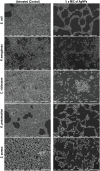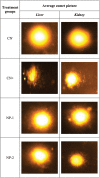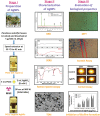Biosynthesized Silver Nanoparticle (AgNP) From Pandanus odorifer Leaf Extract Exhibits Anti-metastasis and Anti-biofilm Potentials
- PMID: 30853939
- PMCID: PMC6396724
- DOI: 10.3389/fmicb.2019.00008
Biosynthesized Silver Nanoparticle (AgNP) From Pandanus odorifer Leaf Extract Exhibits Anti-metastasis and Anti-biofilm Potentials
Abstract
Cancer and the associated secondary bacterial infections are leading cause of mortality, due to the paucity of effective drugs. Here, we have synthesized silver nanoparticles (AgNPs) from organic resource and confirmed their anti-cancer and anti-microbial potentials. Microwave irradiation method was employed to synthesize AgNPs using Pandanus odorifer leaf extract. Anti-cancer potential of AgNPs was evaluated by scratch assay on the monolayer of rat basophilic leukemia (RBL) cells, indicating that the synthesized AgNPs inhibit the migration of RBL cells. The synthesized AgNPs showed MIC value of 4-16 μg/mL against both Gram +ve and Gram -ve bacterial strains, exhibiting the anti-microbial potential. Biofilm inhibition was recorded at sub-MIC values against Gram +ve and Gram -ve bacterial strains. Violacein and alginate productions were reduced by 89.6 and 75.6%, respectively at 4 and 8 μg/mL of AgNPs, suggesting anti-quorum sensing activity. Exopolysaccharide production was decreased by 61-79 and 84% for Gram -ve and Gram +ve pathogens respectively. Flagellar driven swarming mobility was also reduced significantly. Furthermore, In vivo study confirmed their tolerability in mice, indicating their clinical perspective. Collective, we claim that the synthesized AgNPs have anti-metastasis as well as anti-microbial activities. Hence, this can be further tested for therapeutic options to treat cancer and secondary bacterial infections.
Keywords: anti-biofilm; anti-metastasis; molecular docking; quorum sensing; silver nanoparticles (AgNPs).
Figures








Similar articles
-
Biosynthesized Silver Nanoparticles from Eruca sativa Miller Leaf Extract Exhibits Antibacterial, Antioxidant, Anti-Quorum-Sensing, Antibiofilm, and Anti-Metastatic Activities.Antibiotics (Basel). 2022 Jun 25;11(7):853. doi: 10.3390/antibiotics11070853. Antibiotics (Basel). 2022. PMID: 35884107 Free PMC article.
-
Rapid biosynthesized AgNPs from Gelidiella acerosa aqueous extract mitigates quorum sensing mediated biofilm formation of Vibrio species-an in vitro and in vivo approach.Environ Sci Pollut Res Int. 2017 Dec;24(35):27254-27268. doi: 10.1007/s11356-017-0296-4. Epub 2017 Sep 30. Environ Sci Pollut Res Int. 2017. PMID: 28965300
-
Biogenesis of silver nanoparticles using leaf extract of Indigofera hirsuta L. and their potential biomedical applications (3-in-1 system).Artif Cells Nanomed Biotechnol. 2018;46(sup1):1138-1148. doi: 10.1080/21691401.2018.1446967. Epub 2018 Mar 7. Artif Cells Nanomed Biotechnol. 2018. PMID: 29513113
-
Bactericidal application and cytotoxic activity of biosynthesized silver nanoparticles with an extract of the red seaweed Pterocladiella capillacea on the HepG2 cell line.Asian Pac J Cancer Prev. 2014;15(3):1299-306. doi: 10.7314/apjcp.2014.15.3.1299. Asian Pac J Cancer Prev. 2014. PMID: 24606456
-
Biosynthesis of silver nanoparticles using leaf extract of Aesculus hippocastanum (horse chestnut): Evaluation of their antibacterial, antioxidant and drug release system activities.Mater Sci Eng C Mater Biol Appl. 2020 Feb;107:110207. doi: 10.1016/j.msec.2019.110207. Epub 2019 Oct 30. Mater Sci Eng C Mater Biol Appl. 2020. PMID: 31761206
Cited by
-
Bio-inspired facile fabrication of silver nanoparticles from in vitro grown shoots of Tamarix nilotica: explication of its potential in impeding growth and biofilms of Listeria monocytogenes and assessment of wound healing ability.RSC Adv. 2020 Aug 17;10(50):30139-30149. doi: 10.1039/d0ra04587j. eCollection 2020 Aug 10. RSC Adv. 2020. PMID: 35518236 Free PMC article.
-
An effective antibiofilm strategy based on bacteriophages armed with silver nanoparticles.Sci Rep. 2024 Apr 20;14(1):9088. doi: 10.1038/s41598-024-59866-y. Sci Rep. 2024. PMID: 38643290 Free PMC article.
-
Myco-Biosynthesis of Silver Nanoparticles, Optimization, Characterization, and In Silico Anticancer Activities by Molecular Docking Approach against Hepatic and Breast Cancer.Biomolecules. 2024 Sep 18;14(9):1170. doi: 10.3390/biom14091170. Biomolecules. 2024. PMID: 39334936 Free PMC article.
-
Impeding microbial biofilm formation and Pseudomonas aeruginosa virulence genes using biologically synthesized silver Carthamus nanoparticles.Microb Cell Fact. 2024 Sep 5;23(1):240. doi: 10.1186/s12934-024-02508-9. Microb Cell Fact. 2024. PMID: 39238019 Free PMC article.
-
Synthesis of silver nanoparticles utilizing various biological systems: mechanisms and applications-a review.Prog Biomater. 2020 Sep;9(3):81-95. doi: 10.1007/s40204-020-00135-2. Epub 2020 Jul 11. Prog Biomater. 2020. PMID: 32654045 Free PMC article. Review.
References
-
- Accelrys Software Inc. (2013). Discovery Studio Modeling Environment, Release 4.0. San Diego, CA: Author.
-
- Ahluwalia V. K., Kidwai M. (2004). “Microwave induced green synthesis,” in New Trends in Green Chemistry, eds Ahluwalia V. K., Kidwai M. (Dordrecht: Springer; ), 59–72. 10.1007/978-1-4020-3175-5_9 - DOI
-
- Ahmed F., Kumar S., Arshi N., Anwar M. S., Koo B. H., Lee C. G. (2011). Rapid and cost effective synthesis of ZnO nanorods using microwave irradiation technique. Funct. Mater. Lett. 4 1–5. 10.1142/S1793604711001531 - DOI
-
- Alajmi M. F., Ahmed J., Hussain A., Ahamad T., Alhokbany N., Amir S., et al. (2018). Green synthesis of ultrafine Fe3O4 nanoparticles using aqueous extracts of plant leaves for efficient bifunctional electro-catalytic activity. Appl. Nanosci. 8 1427–1435. 10.1007/s13204-018-0795-8 - DOI
LinkOut - more resources
Full Text Sources

